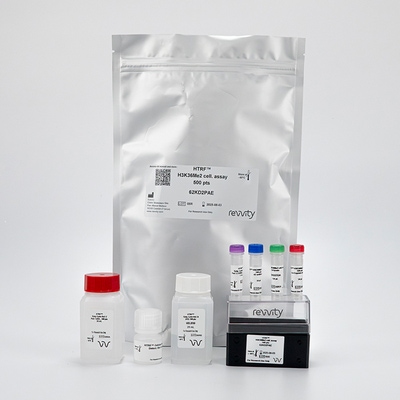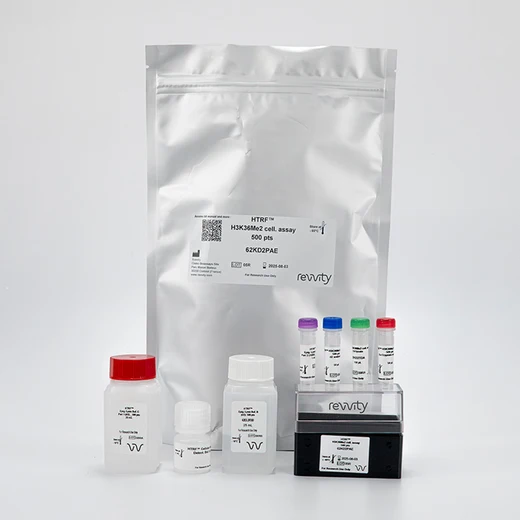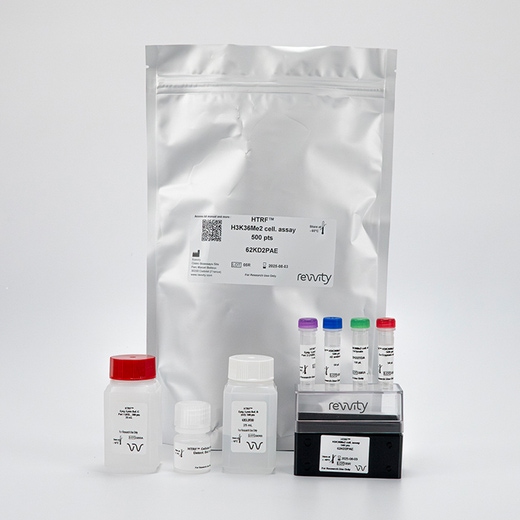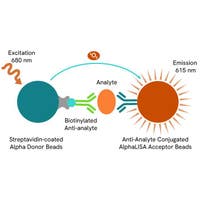

HTRF EPIgeneous 2-methyl K36 Histone H3 Detection Kit, 500 Assay Points


HTRF EPIgeneous 2-methyl K36 Histone H3 Detection Kit, 500 Assay Points






This cell-based assay format enables the detection of the H3K36Me2 motif, as a result of histone H3 methylation by EZH2 enzyme among others.
| Feature | Specification |
|---|---|
| Application | Biochemical Enzymatic Assay |
| Sample Volume | 120 µL |
This cell-based assay format enables the detection of the H3K36Me2 motif, as a result of histone H3 methylation by EZH2 enzyme among others.



HTRF EPIgeneous 2-methyl K36 Histone H3 Detection Kit, 500 Assay Points



HTRF EPIgeneous 2-methyl K36 Histone H3 Detection Kit, 500 Assay Points



Product information
Overview
This cellular assay has been developed with optimized reagents and protocols for the direct detection of endogenous levels of H3K36Me2. This HTRF® format uses a very specific antibody pair combined with a highly efficient nucleus extraction which enables the assay to be used with a variety of cell backgrounds, and for the study of important methyltransferases and demethylases targets, such as JMJD2A. The H3K36Me2 assay can be used for adherent or suspension cells, primary or secondary screening and inhibitor studies.
Specifications
| Application |
Biochemical Enzymatic Assay
|
|---|---|
| Brand |
EPIgeneous
|
| Detection Modality |
HTRF
|
| Molecular Modification |
Methylation
|
| Product Group |
Kit
|
| Sample Volume |
120 µL
|
| Shipping Conditions |
Shipped in Dry Ice
|
| Target Class |
Epigenetics
|
| Technology |
TR-FRET
|
| Therapeutic Area |
Metabolism/Diabetes
Neuroscience
Oncology & Inflammation
|
| Unit Size |
500 assay points
|
Video gallery

HTRF EPIgeneous 2-methyl K36 Histone H3 Detection Kit, 500 Assay Points

HTRF EPIgeneous 2-methyl K36 Histone H3 Detection Kit, 500 Assay Points

How it works
Phospho-AKT1 (Ser473) assay principle
The dimethylation of Lysine 36 on histone H3 is detected in a sandwich assay format using 2 different specific antibodies, one labeled with Eu-Cryptate (donor) and the second with d2 (acceptor). When the dyes are in close proximity, the excitation of the donor with a light source triggers a Fluorescence Resonance Energy Transfer (FRET), which in turn fluoresces at a specific wavelength (665 nm). One conjugate binds to Histone H3 and the other binds to the K36Me2 mark. The specific signal modulates positively in proportion to trimethylation on Lysine 36.

Two-plate assay protocol
Cells are plated (stimulated) and lysed in the same culture plate and then transferred to the assay plate for the detection of H3K36Me2 by HTRF reagents. This protocol enables the cells viability and confluence to be monitored.

One-plate assay protocol
Detection of H3K36Me2 with HTRF reagents is performed in a single plate used for plating, stimulation and detection. No washing steps are required. This protocol, HTS designed, allows miniaturization while maintaining HTRF quality.

Assay validation
HTRF detection of H3K36Me2 with two plate protocol on HeLa cells.
Cells were seeded at various densities in a 96-well plate and incubated for several different times before lysis. Panel A had a lysis step made without discarding the medium. Panel B had a lysis step carried out when the medium was discarded. Optimization of cell densities is required in order to establish the best condition suited for the incubation time desired. For example, whatever the incubation time, a hook effect occurred over 30,000 cells per well. A protocol on adherent cells, with the medium discarded prior to the lysis step, can enhance the assay sensitivity.

Detection of H3K36Me2 with 2 different cell lines
HTRF detection of H3K36Me2 mark with the two plate protocol in two cell lines: HeLa and U2OS. Cells were seeded at various densities in a 96-well plate and incubated for 24h before lysis without medium. Detection of H3K36Me2 was performed in a 384w white plate on a BMG Pherastar FS Flash lamp reader. For both cell lines, a hook effect was observed for the 30,000 cells per well concentration. For the same cellular concentration, U2OS showed an increase level of dimethylation on H3K36.

Antibody Specificity
HeLa were seeded at a density of 12 000 cells per well in a 96-well plate and lysed after a 4 hour incubation. One concentration (10µM) of each Histone H3 derived peptide, bearing various epigenetic methyl marks, was added to the detection well before the addition of HTRF detection conjugates. As H3K36Me1 and H3K36Me2 peptides are the only peptides to compete with the antibodies, testing was carried out with serial dilutions in order to estimate the IC50 value (280nM for H3K36Me2 and > 10µM for H3K36Me1). The kit displayed more than 30 fold selectivity for H3K36Me2 over H3K36Me1


Resources
Are you looking for resources, click on the resource type to explore further.
Discover the versatility and precision of Homogeneous Time-Resolved Fluorescence (HTRF) technology. Our HTRF portfolio offers a...
This guide provides you an overview of HTRF applications in several therapeutic areas.
SDS, COAs, Manuals and more
Are you looking for technical documents related to the product? We have categorized them in dedicated sections below. Explore now.
- LanguageEnglishCountryUnited States
- LanguageFrenchCountryFrance
- LanguageGermanCountryGermany
- Lot Number05SLot DateNovember 5, 2025
- Lot Number05RLot DateAugust 9, 2025
- Lot Number05QLot DateJuly 15, 2024
- Resource TypeManualLanguageEnglishCountry-


Recently viewed

How can we help you?
We are here to answer your questions.






























